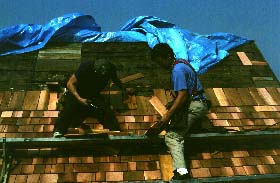 Keeping
a watertight roof on a barn is probably the number one maintenance task.
Water from a leaky roof will rot roof boards, rafters, framing, and floors
and damage what is stored in the barn.
Keeping
a watertight roof on a barn is probably the number one maintenance task.
Water from a leaky roof will rot roof boards, rafters, framing, and floors
and damage what is stored in the barn.TAKING
CARE OF YOUR OLD BARN
Tip # 3 - Keep a Good Roof on It.
 Keeping
a watertight roof on a barn is probably the number one maintenance task.
Water from a leaky roof will rot roof boards, rafters, framing, and floors
and damage what is stored in the barn.
Keeping
a watertight roof on a barn is probably the number one maintenance task.
Water from a leaky roof will rot roof boards, rafters, framing, and floors
and damage what is stored in the barn.
Historically roof coverings on agricultural
buildings range from the earliest wooden shingles (generally prior to 1850)
through slate and early metal (from about 1850 to 1940) to the asphalt
shingles and modern metal of today. Each has different requirements for
maintenance and repair, but all provide a watertight roof, and slate and
metal will last for generations if properly maintained. (Corrugated fiberglass
sheets are not compatible with the historic character of old barns.)
Check your roof at least once a year to see that it is watertight.
Use binoculars to scan the outside, systematically following the rows where
roofing overlaps and all flashing. Pay particular attention to potential
problem areas where roofing or flashing may fail, such as the ridges, eaves,
valleys, around cupolas, along intersecting walls, and anywhere snow and
ice can drop down from a higher roof. Inspect the roof from the inside,
looking for pinholes of daylight or walk through during a heavy rain or
after a snowstorm watching for drips or dark stains. Repair any damaged
flashing. Do not use tar to repair leaks because it is only temporary,
may make the problem worse, and will make correcting the problem even more
expensive.
Wood shingle roofs rarely date from the time a barn was built, though
you may find shingles under another layer of roofing. Once a wood shingle
roof begins to fail, it is usually necessary to replace all of it. If you
choose to do so, select edge-grain red cedar shingles that match the existing
size and thickness. A wood shingle roof requires wood strapping underneath
the shingles for ventilation and drying. The shingles will cup if laid
directly over asphalt roofing or tar paper.
Slate roofs will last up to several hundred years, and it is usually
more economical to repair them than to replace them with other materials.
Every few years you will have to replace several broken or missing slates.
A roofing contractor familiar with slate roof repairs will give you the
best price and be able to match the size and color of existing slates.
Be wary of offers by contractors to remove your slate for salvage and install
a new material; they may simply be selling you what they know how to do
rather than what is your best and most economical option. Be sure to use
adequate staging during repairs to slate and flashing. Slates will crack
and need replacement if the roof is walked on. Hang replacement and new
slates with stainless steel or copper nails and hooks, which will not rust
through.
Metal roofing, including early galvanized metal, standing seam,
and corrugated roofing, is very durable, but may need painting to prevent
rust after its original coating wears off. Coatings range in increasing
cost and durability from galvanized to a baked (usually colored) finish
to lead-coated, which is used for jobs that must last fifty years or more.
Beyond rust, the most serious threat to these roofs is wind damage. Wind
may lift sheets along the outside edges of the roof and the ridge cap.
Nails in corrugated roofing tend to work loose slowly, so they should occasionally
be hammered back down to prevent wind damage. Sheets may be single or double-locked
where they join; double locking is both more secure and expensive. Make
sure gaskets or grommets are used on the nails or screws that fasten down
the roof to avoid leaks.
Asphalt roofing is less durable than slate or metal, typically lasting
between ten and twenty-five years. Although you can repair small holes
or replace blown-off shingles, may be done, once asphalt begins to leak
the whole roof generally must be replaced. Sunlight on the south side or
moisture on the north side of roofs may lead to one side wearing out before
the other. If possible use a ladder to inspect an asphalt roof, since detecting
the areas where the mineral surface has worn away may be difficult from
the ground. Tab shingles often wear through between the tabs first. When
you replace an asphalt roof, if the roof boards are solid, it is acceptable
to install a second layer of shingles over a worn first layer. If there
are already two layers, remove all the shingles and repair the roof boards
before installing new roofing.
Decide to replace a roof only after exploring the repair options
discussed above. As you choose the type of new roof you will buy, consider
durability as well as cost. If possible the new roofing material should
match the existing material or that of a known earlier roof covering. Since
proper flashing is very important and varies with different materials and
conditions, make sure that you or your contractor know which flashing materials
and techniques are right for your roof.
© 1995 Vermont Division for Historic Preservation and Vermont Housing and Conservation Board. All rights reserved.